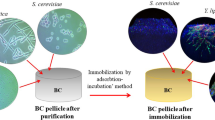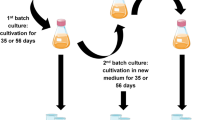Abstract
The present study aimed to explore and describe the properties of bacterial cellulose (BC) membranes obtained from three different strains of Gluconacetobacter xylinus for 72, 120, and 168 h, used as a carrier support for the immobilization of Saccharomyces cerevisiae. The experiments also included the analysis of glucose consumption and alcohol production during the fermentation process displayed by yeasts immobilized on the BC surface. The results of the present study demonstrate that the number of immobilized yeast cells is dependent on the type of cellulose-synthesizing strain, cellulose form, and duration of its synthesis. The BC in the form of wet membranes obtained after 3 days of synthesis displayed the most favorable properties as a carrier for yeast immobilization. The immobilization of yeast cells on BC, regardless of its form, increased the amount of the produced alcohol as compared to free cells. The yeast cells immobilized in BC were able to multiply on its surface during the fermentation process.
Similar content being viewed by others
References
Kourkoutas, Y., Bekatorou, A., Banat, I. M., Marchant, R., & Koutinas, A. A. (2004). Immobilization technologies and support materials suitable in alcohol beverages production: a review. Food Microbiology, 21(4), 377–397.
Ivanova, V., Petrova, P., & Hristov, J. (2011). Application in the ethanol fermentation of immobilized yeast cells in matrix of alginate/magnetic nanoparticles, on chitosan-magnetite microparticles and cellulose-coated magnetic nanoparticles. International Review of Chemical Engineering, 3(2), 89–299.
Verbelen, P. J., De Schutter, D. P., Delvaux, F., Verstrepen, K. J., & Delvaux, F. R. (2006). Immobilized yeast cell systems for continuous fermentation applications. Biotechnology Letters, 28(19), 1515–1525.
Strehaiano, P., Ramon-Portugal, F. and Taillandier, P. 2006. Yeasts as biocatalysts. In: Querol, A., Fleet, G. (Eds) Yeasts in food and beverages, pp. 243–284.
Yao, W., Wu, X., Zhu, J., Sun, B., Zhang, Y. Y., & Miller, C. (2011). Bacterial cellulose membrane—a new support carrier for yeast immobilization for ethanol fermentation. Process Biochemistry, 46(10), 2054–2058.
Chandel, A. K., Narasu, M. L., Chandrasekhar, G., Manikyam, A., & Rao, L. V. (2009). Use of Saccharum spontaneum (wild sugarcane) as biomaterial for cell immobilization and modulated ethanol production by thermotolerant Saccharomyces cerevisiae. Bioresource Technolology, 100(8), 2404–2410.
Nguyen, D. N., Ton, N. M. N., & Le, V. V. M. (2009). Optimization of Saccharomyces cerevisiae immobilization in bacterial cellulose by ‘adsorption-incubation’ method. International Food Research Journal, 16, 59–64.
Czaja, W., Krystynowicz, A., Bielecki, S., & Brown, R. M., Jr. (2006). Microbial cellulose—the natural power to heal wounds. Biomaterials, 27(2), 145–151.
Ruka, D. R., Simon, G. P., & Dean, K. M. (2012). Altering the growth conditions of Gluconacetobacter xylinus to maximize the yield of bacterial cellulose. Carbohydrate Polymers, 89(2), 613–622.
Wu, S.-C., & Lia, J.-K. (2008). Application of bacterial cellulose pellets in enzyme immobilization. Journal of Molecular Catalysis B: Enzymatic, 54(3–4), 103–108.
Ton, N. M. N., Nguyen, M. D., Pham, T. T. H., & Le, V. V. M. (2010). Influence of initial pH and sulfur dioxide content in must on wine fermentation by immobilized yeast in bacterial cellulose. International Food Research Journal, 17, 743–749.
Keshk, S. (2014). Bacterial cellulose production and its industrial applications. Journal Bioprocessing Biotechniques, 4(2), 1360–1401.
Ton, N. M. N., & Le, V. V. M. (2011). Application of immobilized yeast in bacterial cellulose to the repeated batch fermentation in wine-making. International Food Research Journal, 18(3), 983–987.
Hornung, M., Ludwig, M., Gerrard, A. M., & Schmauder, H.-P. (2006). Optimizing the production of bacterial cellulose in surface culture: evaluation of substrate mass transfer influences on the bioreaction (part 1). Engineering in Life Sciences, 6(6), 537–545.
Mikkelsen, D., Flanagan, B. M., Dykes, G. A., & Gidley, M. J. (2009). Influence of different carbon sources on bacterial cellulose production by Gluconacetobacter xylinus strain ATCC 53524. Journal of Applied Microbiology, 107(2), 576–583.
Sheykhnazari, S., Tabarsa, T., Ashori, A., Shakeri, A., & Golalipour, M. (2011). Bacterial synthesized cellulose nanofibers: effects of growth times and culture mediums on the structural characteristics. Carbohydrate Polymers, 86(3), 1187–1191.
Ciechańska, D., Struszczyk, H., & Gruzińska, K. (1998). Modification of bacterial cellulose. Fibres Textile in Eastern Europe, 4(23), 61–65.
Jonas, R., & Farah, L. F. (1998). Production and application of microbial cellulose. Polymer Degradation and Stability, 59(1–3), 101–106.
Klemm, D., Schumann, D., Udhardt, U., & Marsch, S. (2001). Bacterial synthesized cellulose—artificial blood vessels for microsurgery. Progress in Polymer Science, 26(9), 1561–1603.
Iguchi, M., Yamanaka, S., & Budhiono, A. (2000). Bacterial cellulose—a masterpiece of nature’s arts. Journal of Materials Science, 35(2), 261–270.
Rezaee, A., Godini, H., & Bakhtou, H. (2008). Microbial cellulose as support material for the immobilization of denitrifying bacteria. Environmental Engineering and Management Journal, 7(5), 589–594.
Hamerska-Dudra, A., Bryjak, J., & Trochimczuk, A. W. (2007). Immobilization of glucoamylase and trypsin on crosslinked thermosensitive carriers. Enzyme and Microbial Technology, 41(3), 197–204.
Ul Islam, M., Khan, T., & Park, J. K. (2012). Water holding and release properties of bacterial cellulose obtained by in situ and ex situ modification. Carbohydrate Polymers, 88(2), 596–603.
Dahman, Y. (2009). Nanostructured biomaterials and biocomposites from bacterial cellulose nanofibers. Journal of Nanoscience and Nanotechnology, 9(9), 5105–5122.
Guo, J., & Catchmark, J. M. (2012). Surface area and porosity of acid hydrolyzed cellulose nanowhiskers and cellulose produced by Gluconacetobacter xylinus. Carbohydrate Polymers, 87(2), 1026–1037.
Tang, W., Jia, S., Jia, Y., & Yang, H. (2010). The influence of fermentation conditions and post-treatment methods on porosity of bacterial cellulose membrane. World Journal Microbiology and Biotechnology, 26(1), 125–131.
Acknowledgments
This work was supported by the National Centre for Research and Development in Poland (Grant No. LIDER/011/221/L-5/13/NCBR/2014).
Author information
Authors and Affiliations
Corresponding author
Rights and permissions
About this article
Cite this article
Żywicka, A., Peitler, D., Rakoczy, R. et al. Wet and Dry Forms of Bacterial Cellulose Synthetized by Different Strains of Gluconacetobacter xylinus as Carriers for Yeast Immobilization. Appl Biochem Biotechnol 180, 805–816 (2016). https://doi.org/10.1007/s12010-016-2134-4
Received:
Accepted:
Published:
Issue Date:
DOI: https://doi.org/10.1007/s12010-016-2134-4




